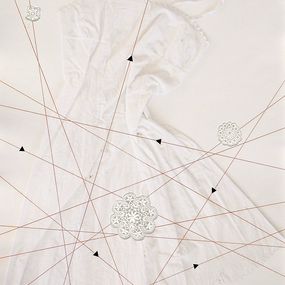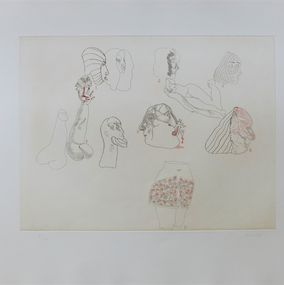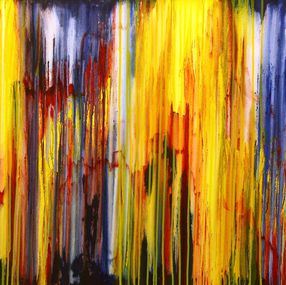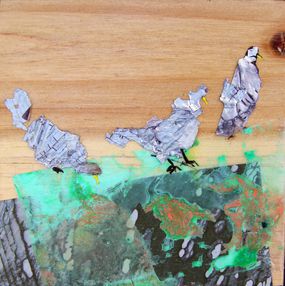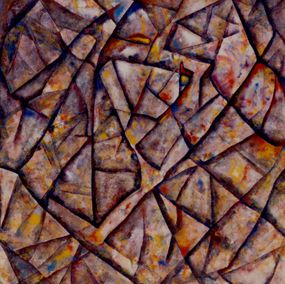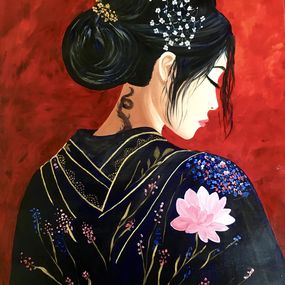
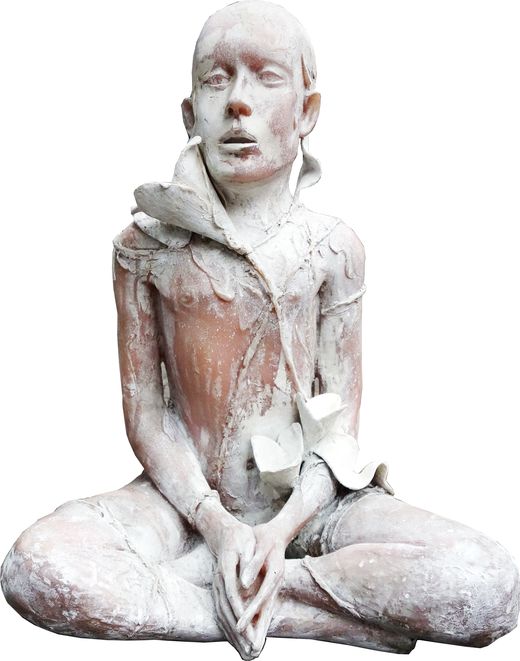
Biography
Omid Hallaj was born in Tehran, Iran in 1980. In 2009, he graduated with a B.A. in Painting from Tehran's Elm o Farhang University. Since 1996, his work has been exhibited in six solo shows and ten group shows.Taking inspiration from visions he sees in dreams, Hallaj paints a lost paradise of marshes and swamps where human forms in their most primeval state emerge in the midst of luxuriant vegetation and unidentifiable animals. Hallaj's works address both the beauty of creation and a process inherent within it. Man's alienation from nature, and from himself. He currently works and teaches in Tehran.
The recent work of Omid Hallaj is a continuation of his well-known mental space, and the result of the ardent suspense of the artist on the border between dualities such as fantasy and reality, and dream and consciousness. Hc seeks to capture the eternal and eternal moments that are both signs of our familiar world and bring us a form from the onset of the appearance of things or the conversion of beings to one another. Man in his work is sometimes in high regard, but this role is not the key to most of the work, and his people are less prosperous than ever. Man is the victim of most of his work, or is seen to be ineffective, or he remains under the control of animals or caught between herbs. In this fantasy world, man has been pulled down from power, and his nudity is a disgrace to him.
HG eliminates the signs of gender from the body, so that the concept of man and his place in the paintings is taken into consideration, and not the hints that the naked body brings with it. His humans are sometimes so busy with plants and other organisms that are depicted on the marginal margins of the world.The work of human beings in neither heaven nor the apocalyptic era, which is entangled in a busy and obscure world, shows that it has a mythical or ritualistic atmosphere without telling a particular story or giving us accurate indications of rituals and myths. In fact, he puts his imaginative spontaneity and imagination in front of the viewer, and, with the knowledge of every sign he wants to bring us to a familiar and definitive result, vanishes and buries under his many pieces of work.
Strange events form an important part of the work of the HG, and this is due to the visual imagery and the possibilities of painting the paint. In one of the works, it splits something like a piece of wood, and reveals the birth or outflow of a new thing. Or in other things, as if you're all alive from the heart of the Creek, and from the very beginning, the monkeys and humans are threatened with their early instants. In this period, he sees the first algebra of humanity as equal, and considers the first threat to be the beginning of Siri, which ultimately sacrifices him to his first act.This is what, in his work, forms the desire to approach the first senses, the first events, and the beginning of the steps in the formation of concepts and things. In another case, a ram is located on the human head and is pouring water from the jar on the ground.These miraculous gestures in his work take on a new look, and so are combined in other events that you can not accurately understand them.
Plants play an important role in illustrating the creation of an attractive aesthetic link between elements of the image, creating a vague and imaginary space. But their appearance in the image of the image is not as a relaxing and beautiful thing that shapes the sense of alienation of the paintings and other beings. Despite the familiar appearance of these plants, they combine with white and gray spectra, and they invade humans.
Animals sometimes also act as sacrifices, sometimes as threatening, but often unaware of their actions, and in the cycle of HG activities, they become elements that create a mental dream that can be interpreted into a world beyond the current order. Iranian painting techniques are sometimes seen in some of his works, and sometimes architectural style is familiar, but all these hints are done with elegance, such as the smoke of a hand-held boy's candle making one of the flags of the same work making a meaningful harmonic work.
The pencil of these works is not solved in the painting structure and does not seem like an imposed element, and the legacy of Iranian art is used in a similar, but modern, context. If we look closely at the sights of Sultan Muhammad (or other Iranian painters), we will find in them something from the turmoil of the world of Hc.
Solo Exhibition
2017 “ Confessional " Iranshahr Gallery,Tehran
2015 “ The Resonant Reflec on " Aun Gallery,Tehran
2013 “ Code Grinder " Aun Gallery,Tehran
2011 “ Court " Aun Gallery,Tehran
2009 “ Out and Burning " Aun Gallery,Tehran
2008 Elahe Gallery, Lale Gallery,Tehran
2005 Lale Gallery,Tehran
2001 Aerand Gallery,Tehran
2000 Seyhoun Gallery,Tehran
1998 Afrand Gallery,Tehran
Selected Group Exhibition
2013 “ The Zoo " Shirin Gallery,Tehran
2013 “ Pain ng Wall " Touch Gallery, Boston
2012 “ Documentary of Sea " XVA Gallery, Dubai/UAE 2011 RX Gallery, Paris/Total Arts Gallery, Dubai
2010 “ Landscape " Aran Gallery,Tehran
2009 Iran/Pain ng/ Now, Silk Road Gallery,Tehran
2008 Mah Gallery/ Homa Gallery,Tehran
2006 Saba Cultural Center,Tehran






